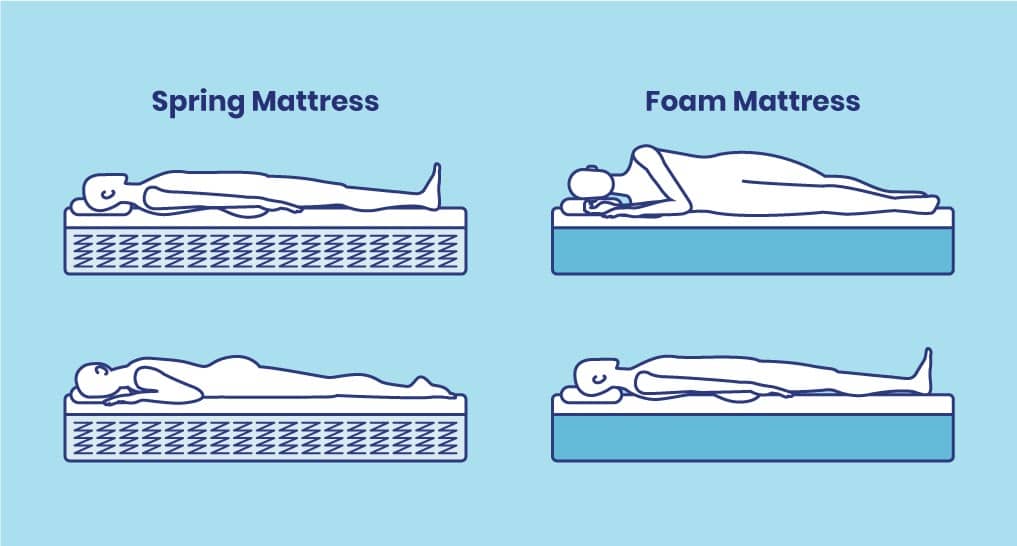Content Attributes
Choosing the ideal mattress might be difficult due to the abundance of options available today. But by determining your sleep requirements and comparing them to several mattress kinds, we can simplify the process for you. Although memory foam mattresses were developed before spring mattresses, this does not imply that one is technologically superior to the other. The two types of mattresses are fundamentally different in how they feel; spring mattresses are bouncy.
While memory foam is more body-conforming and pressure-relieving. Memory Foam Mattress Price is generally higher than spring mattresses. Spring beds were common before memory foam was developed in the 1990s. Differentiating and choosing between the two might be difficult for you.
What is a Spring Mattress?
A spring mattress is constructed of steel or metal coils encased in layers of different materials for comfort and additional support. Four different coil kinds provide different levels of support: continuous, Bonnel, offset, and pocket. While pocket coils are independently wrapped, innerspring coils are typically joined.
What is a Memory Foam Mattress?
Each foam layer used in memory foam mattresses has a different density and level of breathability. The high-density foam gives the bed solidity, while low-density foam is often utilized in the top layer to provide maximum comfort. While some beds have five different layers of foam, some only have two.
These foam layers are frequently infused with additional substances to regulate body temperature better and increase responsiveness. The foam’s structural makeup can also be altered to provide extra comfort and support for sleepers.
Memory Foam vs Spring Mattress
Depending on the most important factors to the buyer, each option has advantages and disadvantages. Here are the various categories where the contrasts between the two stand out.

Cost
Both spring and foam mattresses are available for any budget, though specific construction types will increase the price if you’re on a tight budget.
Support
Good customer support from the mattress company is important, but more important is the support to your back. A memory foam mattress is typically recommended for people with severe back discomfort. Memory foam maintains the alignment of the spine and preserves its natural curvature.
Durability
Foam mattresses are traditionally thought to be more robust and long-lasting, which is usually reflected in their lengthier warranties. While spring mattresses can also endure a long time, there is occasionally a loss of comfort as the springs wear down over time and become less consistent, making them more prone to poking and drooping.
Bounce
Innerspring beds still have the most bounce to them. Since foam mattresses are more shock-absorbing than spring ones, they return to their original positions comfortably instead of quickly springing back. There is a variation in the bounce of various foam mattresses, and latex foam is far more springy and responsive than memory foam.
Temperature
One of the main criticisms about foam mattresses is that they have trouble maintaining a consistent temperature. Because memory foam depends on body heat to become more pliable, it is particularly prone to trapping heat. It then traps this heat, which can be highly uncomfortable for people with body temperature control problems or those who live in hot climates.
Although there are several foam and hybrid alternatives with features expressly designed to keep the sleeper cool, spring mattresses are still typically a more terrific option than foam.
Quality And Price Range
Because spring mattresses have been around for so long, a broader range is frequently available on the market. Compared to more recent foam types, they can provide a more excellent range of sensations, firmness levels, and support at a more comprehensive price point.
Scent
It has been noted that foam mattresses first produce a foul, chemical smell. Although it usually goes away after unboxing, it can make using one a little more obvious the first time.
Movement Absorbency
A spring mattress may cause problems if you share a bed with a restless sleeper. The springs will probably bounce back when they move, making you move along with them. A foam mattress can typically absorb movement better.
Sleeping Position
People who sleep on their stomachs should choose a firmer mattress, such as foam latex. Memory foam might be more suitable because side sleepers typically want something softer to cushion and indent the shoulders and hips.
A typical spring mattress might be an excellent choice for back sleepers since they want a firm-and-soft combination. Again, there are many different models and sensations, so we advise reading each mattress review to help you make the best decision.
Conclusion
In the end, deciding which mattress is the best for you largely depends on your preferences. Although foam mattresses tend to feel more enveloping, spring mattresses can also be unsteady and lack homogeneity. After researching, it’s critical to consider personal tastes instead of generalizations based on the sort of mattress.